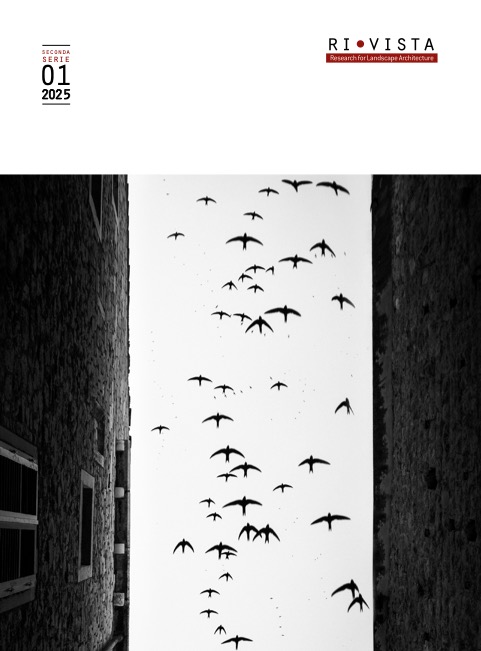Published 2025-10-28
Keywords
- Open space,
- New Town,
- Aspern Seestadt,
- Urban heat islands,
- Climate change
- Landscape design ...More
How to Cite
Copyright (c) 2025 Alessandro Gabbianelli, Luca Montuori

This work is licensed under a Creative Commons Attribution 4.0 International License.
Abstract
The district of Aspern Seestadt, located north-east of Vienna, offers the opportunity for an in-depth reflection on the planning of new urban neighbourhoods in relation to the mitigation of the effects of the climate crisis and the need to ensure a lively and sustainable urban space. Focusing on the characteristics of open space, the article analyses the heat island mitigation guidelines that guided the design of the neighbourhood and the theories developed by Jan Gehl on ‘life between buildings’ and tries to verify their applicability to the design strategies of the parks implemented so far.
The question arises as to whether the Aspern Seestadt project is really inspired by a sustainable urban design approach or whether, rather, an urban model is being pursued that guarantees reassuring, conflict-free, familiar, exclusive spaces (only for certain social groups), but which, in fact, generate a generic landscape.
References
- Asper Airfield project team 2008, Aspern Airfield Masterplan. Executive Summary, Vienna City Administration, MA 21B - District Planning and Land Use, Wien, <https://www.wien.gv.at/pdf/ma21/flugfeldaspern-kurzfassung-masterplan.pdf> (11/24).
- Brandenburg C., et al. 2018, Urban Heat Island Strategy. City of Vienna, Municipality of Vienna, Vienna Environmental Protection and Department – Municipal Department 22, Vienna, <https://digital.wienbibliothek.at/download/pdf/3559581.pdf> (11/24).
- Corner J. 2012, Terra Fluxus, «Lotus International», n. 150, pp. 54-59 (ediz. orig. 2006, Terra Fluxus, in C. Waldheim (a cura di), The Landscape Urbanism Reader, Princeton Architectural Press, New York, pp. 21-33).
- Corner J. (a cura di) 1999, Recovering Landscape. Essay in Contemporary Landscape Architecture, Princeton Architectural Press, New York.
- Cucca R. 2012, The Unexpected Consequences of Sustainability. Green Cities Between Innovation and Ecogentrification, «Sociologica, Italian journal of sociology online», n. 2, pp. 0-0, doi: 10.2383/38269.
- Cucca R. 2017, Social impact of green urban renewal in two European capital cities: Copenhagen and Vienna in comparison, «Environmental Science, Sociology, Political Science», <https://api.semanticscholar.org/CorpusID:56388992> (11/24).
- di Campli A. 2011, La ricostruzione del Crystal Palace. Per un ripensamento del progetto urbano, Quodlibet, Macerata.
- Friesenecker M., Thaler T., & Clar C. 2023, Green gentrification and changing planning policies in Vienna?, «Urban Research & Practice», n.17(3), pp. 393–415, <https://doi.org/10.1080/17535069.2023.2228275> DOI: https://doi.org/10.1080/17535069.2023.2228275
- Sieg H., et al. 2004, Estimating the general equilibrium benefits of large changes in spatially delineated public goods, «International Economic Review , n.45: 1047-1077, <https://doi.org/10.1111/j.0020-6598.2004.00297.x> (11/24) DOI: https://doi.org/10.1111/j.0020-6598.2004.00297.x
- Tocci W. 2009, L’insostenibile ascesa della rendita urbana, «Democrazia e Diritto», n. 1, pp. 17-59. DOI: https://doi.org/10.3280/DED2009-001002
- Gehl Architects 2009, Partitur des öffentlichen Raums. Planungshandbuch, Wien 3420 Aspern Development AG e Magistratsabteilung 18, Vienna, <https://www.aspern-seestadt.at/jart/prj3/aspern/data/downloads/PartiturdesffentlichenRaums_2017-07-12_1607953.pdf> (11/2024).
- Gehl J. 2012, Vita in città: spazio urbano e relazioni sociali, Maggioli, Santarcangelo di Romagna (ed. orig. 1971 Livet mellem husene, København, Arkitektens Forlag).
- Gehl J. 2017, Città per le persone, Maggioli, Santarcangelo di Romagna, (ed. orig. 2010 Cities for People, Island Press, Washington | Covelo | London).
- Giberti E. 2017, Aspern: la città lago di Vienna. Analisi critica delle città di fondazione. Ipotesi di progetto, Tesi di laurea del Corso Magistrale in Architettura per il progetto sostenibile del Politecnico di Torino discussa a settembre 2017, non pubblicata.
- Koolhaas R., Mau B. 1995, S, M, L, XL: Small, Medium, Large, Extra-Large, Rotterdam: 010 Publishers.
- Landsberg Helmut E. 1956, The Climate of Towns, in W. L. Thomas (a cura di), Man’s Role in Changing the Face of the Earth, University of Chicago Press, Chicago, pp. 584-606.
- Landsberg Helmut E. 1981, The Urban Climate, Academic Press, New York.
- Pasini R., Ströbele M., Imbroglini C. 2024 (a cura di), Nuove ecologie/Nuovi significati, «Ri-Vista. Ricerche per la progettazione del paesaggio», n. 1, Vol. 22, <https://doi.org/10.36253/rv-16631> (11/24). DOI: https://doi.org/10.36253/rv-16631
- Spörk I., Imre M., Derdak C. 2024, EVA. Evaluation, Interim Assessment and System of Objectives for aspern Seestadt, Wien 3420 aspern Development AG, Vienna.
- Waldheim C. 2006, The Landscape Urbanism Reader, Princeton Architectural Press, New York.
- Weilacher U. 2011, Landscape architecture in an age of urban transformation, in Bund Deutscher Landschaftsarchitekten (a cura di), Green Living. Contemporary German Landscape Architecture, Birkhäuser, Basel, pp. 8-19.
- Pollak C., et al. 2011, Aspern+ Subprojekt 1 “Freiraum und Mikroklima” D6.3 – Gesamtbericht, Wien, <https://landscape-tuwien.at/forschungsprojekte/projekt/freiraum-und-mikroklima> (05/25).
- Wien 3420 aspern Development AG 2018, Aspern Seestadt. Master Plan Revisited - Status of Planning 2017, Wien 3420 aspern Development AG, Municipal Department 18-Urban Development and Planning, Wien, <https://www.aspern-seestadt.at/jart/prj3/aspern/data/downloads/aspern_masterplan_2017_EN_2019-08-30_1208911.pdf> (11/24).






